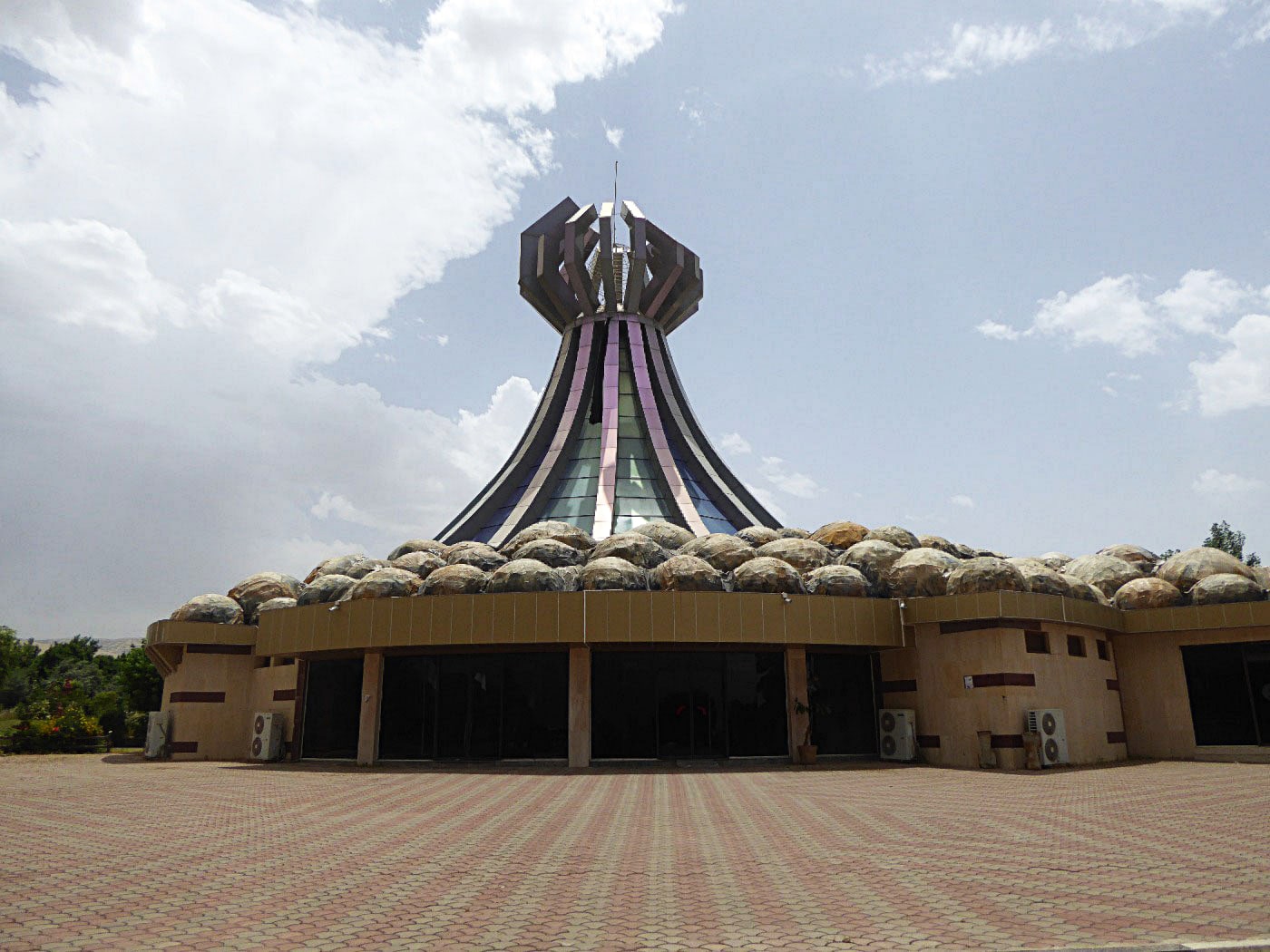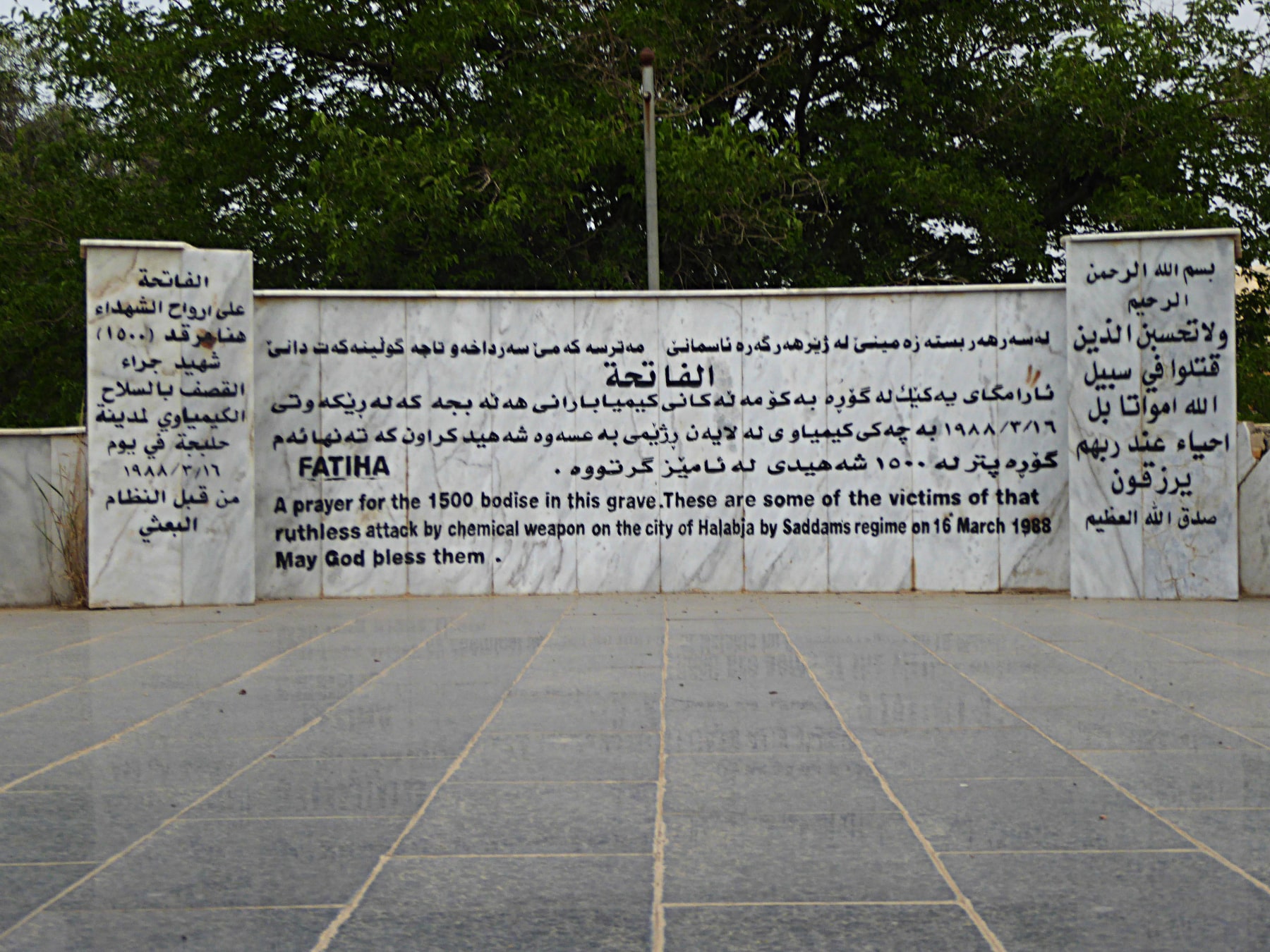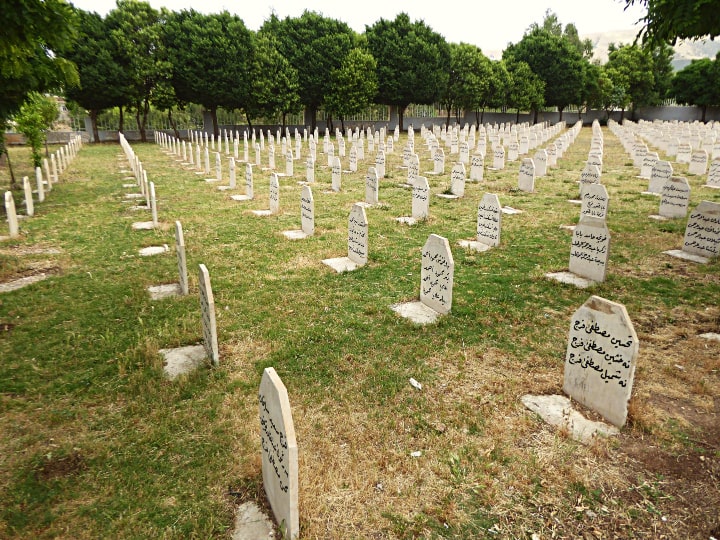Day trip to Halabja – Crimes Against Humanity

Memorial in Halabja dedicated to the victims of the attack.
Today I was in Halabaja it's 1.5 hours Southeast of Sulaymaiyah not to far from the Iranian Border. A minibus, the first use of these I've seen in Iraqi Kurdistan, usually it's shared taxis, they don't really have a bus system in this part of the world but I don't think it will be long given the rate of modernisation in Kurdistan.
The Bus station was again like the previous Taxi Stand in Erbil, highly organised and easy to navigate. All the Minibuses on one side with their direction written overhead on road sign type signage, on the other side were taxis. The bus for the 1.5 hour journey would cost 3500ID or €2.60, pretty good price.
The Minibus filled up quick enough and we were headed on our way, the usual Peshmerga Checkpoint, a cursory slow down and a friendly wave onward.
About 30 Kilometers out from Sulaymaiyah just passed a small town called Arabit, after which a Refugee camp called Ashti run by UNICEF for Internally Displaced Persons or IDPs sadly an all two common site. Ashti is home to 13,684 people according to a 2017 report by The REACH Initiative.
Including Ashti there are 20 Refugee Camps in all of Iraqi Kurdistan, In all of Iraq there are 56 Refugee Camps most of the people in these camps were displaced in May of 2015 and 51% of them are under the age of 18. In 2015 the Islamic State were at their height of power killing everyone and anyone who stood in their way Men, Women and Children, literally bulldozing history to the ground, an arm reaching into Europe planting Suicide Bombers in Turkey, France and Belgium to name a few. These 56 camps include people from Iraq and Syria fleeing the Islamic State and other belligerent groups. As of June 2018 7,218,401 people have been settled in these Refugee Camps June of 2018 according to the UNCHR.
A while later the Minibus was nearing the Halabja Memorial. There is a security guard on the way in, he checks my passport, he has decent English he tells me he has been to much of the UK.
The Anfal Campaign was the brainchild of Ali Hassan al-Majid or perhaps better know as Chemical Ali. Al-Majid was a cousin of the then Iraqi President Saddam Hussein. The Anfal Campaign started from February 1988 to September of 1988, it was a genocide of the Kurdish people, killing anywhere from 50,000 – 182,000 people and destroying some 4,500 Villages, with the use of conventional and chemical weapons and the use of Firing Squads and Mass deportation.
There's a Graveyard on the Eastern side of Halabja. A little far to walk in this heat so I get in a taxi. The Taxi driver has a little English he asks me where I'm from and all the usual broken English questions. I pay him 1500IDs and walked up through the graveyard.

Monument dedicated to the victims of the attack.
A wide central path, on my right is the first mass grave 40 Bodies in all, on my left 1500 bodies and then another with 440. 1980 in total each sharing a largehead stone with an inscription. Further up are individual graves, rows upon rows with each there own little headstone, these were the lucky ones, these could be identified, there families knew who they were.
Back in Sulaymaiyah, there is a place called Amna Suraka, The Tuol Sleng (Cambodia Killing Fields etc) of Iraq. Amna Suraka functioned as the Headquarters of the Northern division of the Mukhabarat this was Iraq's Secret intelligence agency. This place was built between 1986 and 1989 during the Saddam's Reign.
Amna Suraka was used as a place of Planning, Killing and Torture, its largely left untouched, The first room you go into is a hall of mirrors each mirror represents a person that was killed during the Anfal Campaign there are 182,000 pieces of broken mirror, on the ceiling are 4,500 small electrical lights these are for each of the Kurdish villages that were destroyed by Saddam's forces.
Thousands of Human beings were brought here for being Kurdish, they were tortured and executed. This stopped during the Gulf War in 1991 when what were then a small Guerilla army of Peshmerga started an uprising to liberate Northern Iraq with the an aim to liberate the whole country, although they fell short of this they did however manage to capture Amna Suraka. Saddam Hussein managed to keep his seat of power until the US led invasion of Iraq in March of 2003. The coalition of 37 countries including the Peshmerga army in the North had much control on Iraq within three weeks.
On the 13th of December 2003 Saddam Hussein was found in a cave near Tikrit not to far from where he was born. Saddam was brought to an American Base and eventually handed over to the Interim Iraqi Government where he was later sentenced to death by hanging for crimes against humanity on the 30th of December 2006.
Chemical Ali was also sentenced to death by hanging and was executed on the 25th of January 2010.
A lot of the reading I've done for this echos with the reports I've read coming out of Syria, from independent groups like OPCW, SOHR, SNHR and even many media organisations like Reporters Without Borders, France24, Al-Jazeera and the of course governmental groups like the UN. The above writing about the Anfal Campaign only needs a few key words changed such as Iraq for Syria and Saddam Hussein with Bashar al-Asad. This is not history, this is something that is happening right now today. Many thousands of documents which tell stories of torture facilities and Chemical weapons have been found in abandoned Syrian government buildings, taken across borders into Turkey and other ways, being verified by human rights organisations.
Syria does not fall under the ICC International Criminal Court jurisdiction, however the places that refugees are fleeing to are in the ICC's territory. Human Rights Lawyers in Jordan have filed cases on behalf of 28 Syrian refugees who were forced to flee the country, they were shot at and bombed during the early days of the Arab Spring in 2011.

Family graves at Halabja.